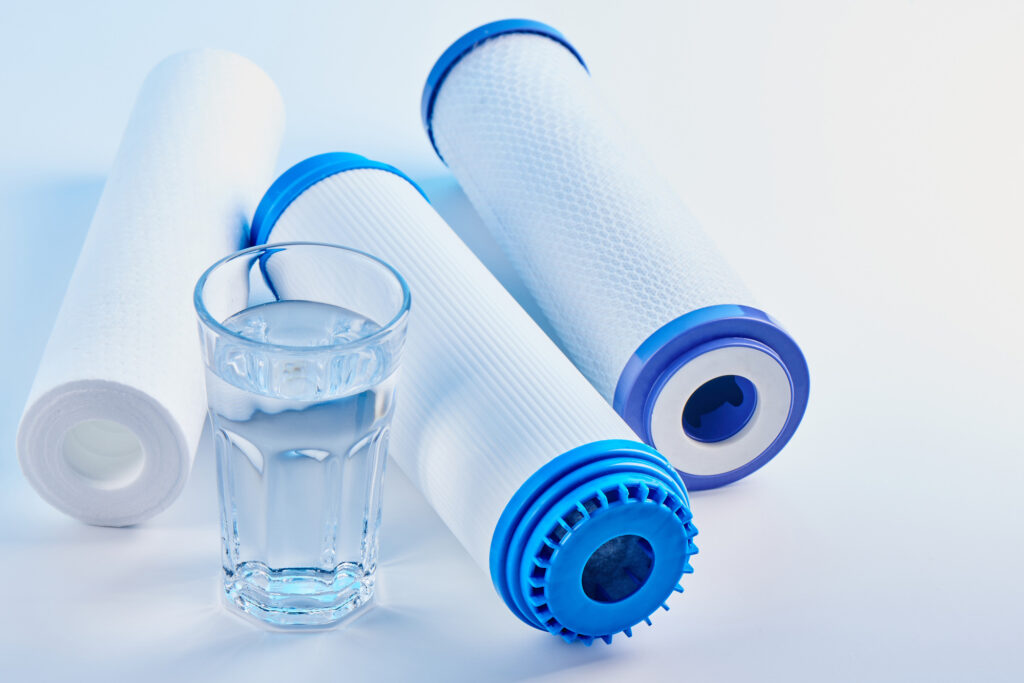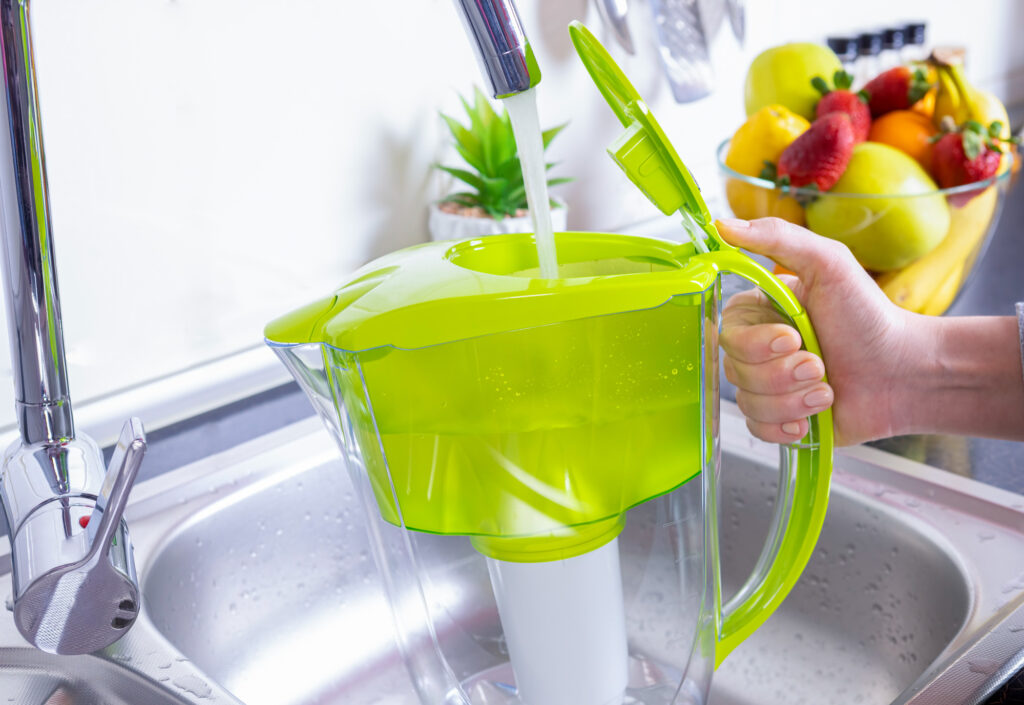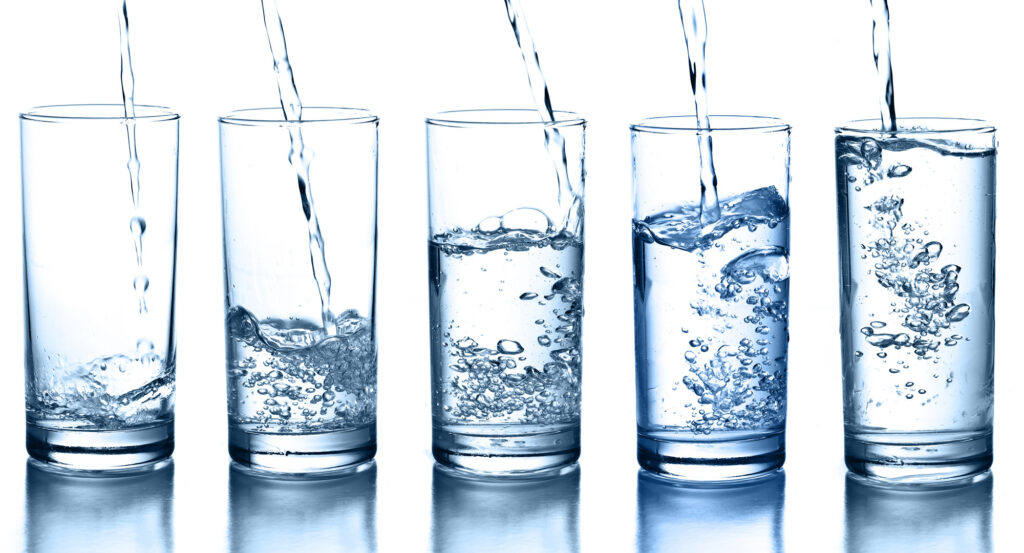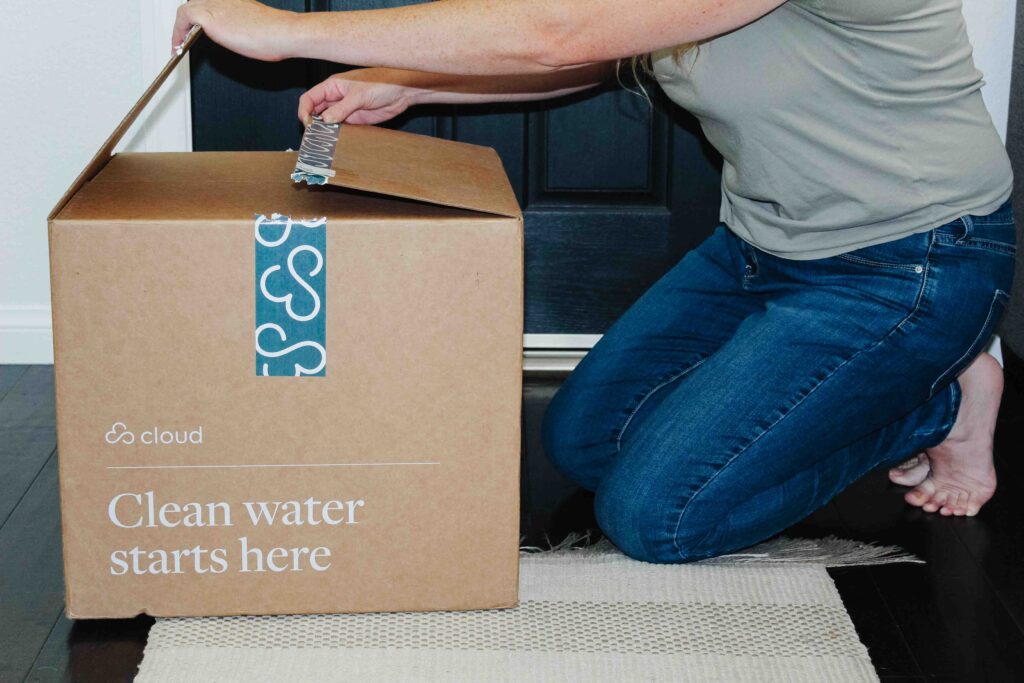Curious which water filter removes lead? Here we’ll explore different water filters and why you should look for one that removes lead.

One of ten chemicals of public health concern identified by the World Health Organization (WHO) is lead. Lead is one of the toxic heavy metals which occurs naturally in the Earth in trace amounts. The use of lead in industries such as battery, pigment, plastic, solders ammunition and ceramics manufacturing, as well as battery recycling, lead smelting and processing industries have contributed to the release of lead into the environment.
Lead often ends up in water, leaving many of us to wonder which water filter removes lead?
Disclaimer: This post includes affiliate links, and we will earn a commission if you purchase through these links. Please note that We’ve linked to these products purely because we recommend them, and they are from companies we trust. There is no additional cost to you.
How does lead enter water?
When lead is released from industrial sources into the air, it can fall on the ground, adhering to soil particles, and eventually migrating into ground water. Lead’s toughness, malleability, and ability to bend with ease makes it the perfect metal for water pipes, which is why there are many lead pipes. This has contributed to lead in drinking water.
In plumbing materials made from lead, corrosion causes the metal from the pipes to dissolve into the water. When the water is highly acidic or has low mineral concentration, the reaction is more severe. In homes where lead service lines are not in use, brass or chrome-plated brass faucets and plumbing with lead solder are other sources of lead in drinking water.
What are the health problems caused by lead?
Lead poisoning occurs when lead accumulates in the body over a long period of time. Lead poisoning can be difficult to detect at first, as even healthy people can have high levels of lead in their blood. Signs and symptoms of lead poisoning do not normally develop until unsafe levels have been reached.
Long-term lead exposure to lead in adults can result in cardiovascular problems such as increased blood pressure and hypertension, decreased kidney function, and reproductive issues in both men and women. Signs and symptoms in adults range from abdominal pain, nausea, headache, joint and muscle pain, to sleep, memory and concentration issues at minimum blood lead level of 40 μg/dL.
According to WHO, when it comes to lead poisoning, the most vulnerable are young children and most susceptible undernourished children. Young children absorb 4-5 times “as much ingested lead as adults from a given source”, and undernourished children tend to absorb more lead into their bodies when essential nutrients like calcium and iron are lacking.
Low levels of exposure in children have been associated to central and peripheral nervous system damage, learning problems, shorter stature, reduced hearing, and impaired blood cell formation and function
A study was carried out to examine the association of intelligence test scores and blood lead concentration in children with blood lead levels < 10 μg/dL. The study showed that there is an association with intellectual deficits in children who have maximal blood lead levels < 7.5 μg/dL.
Lead’s neurological and behavioral impacts are thought to be irreversible. Exposure of pregnant women to high levels of lead can cause miscarriage, stillbirth, premature birth and low birth weight. Lead can be transmitted through breast milk, and across the placenta to fetus.

Is there a safe level of lead in water?
The Environmental Protection Agency (EPA) is required under the Safe Drinking Water Act (SDWA) to identify pollutant levels in drinking water, at which there are no adverse health consequences. Because lead is a hazardous metal that can impair human health even at low exposure levels, the EPA has set a zero maximum contaminant level.
Which water filter removes lead?
Below is a list of water filters that will remove lead from your water. They are sorted based on type of water filter to help you find which works best for you.
When looking for a water filter, look for a one that has a certification. Certification of water filters is handled by a number of organizations, including National Sanitation Foundation (NSF) and Water Quality Association (WQA).
The NSF is an international non-profit organization that develops standards, tests, and certifies products in order to preserve human health and the environment. NSF International drinking water certification programs are accredited by American National Standards Institute (ANSI standards). Water filters that remove lead in water are tested and certified to NSF/ANSI 53 and 58 standards.
WQA is also a non-profit association for the residential commercial, and industrial water treatment industry, fully accredited by ANSI. The WQA Gold Seal Program carries out testing and certification of drinking water treatment units, system components, additives, pool and spa equipment, and food equipment to NSF/ANSI standards. WQA’s Certified Product Listings are available to link consumers with tested and certified water treatment products.
Which water filter is right for me?
The best water filter for you will depend on your needs.
There are various types of water filters. Generally, they are grouped into two; point-of-entry and point-of-use water filters. Point-of-entry filters work to filter water at the source and are attached to your main water line, ensuring all the water going into your home is filtered.
Point-of-use filters filter water immediately before usage (such as a sink attachment or water pitcher).
Budget, level of maintenance, where you want to put them, amount of harmful contaminates removed and certification should all be considered when choosing a water filter.
Pitcher filters that remove lead

Water Pitcher filters are examples of point-of-use filters. There are two parts to a standard water pitcher. The upper half of the device is made up of a filter fitted at the center which water is poured into, and the lower half which is where you obtain the now filtered water.
Activated carbon pitchers are the most common, but ceramic filters, and ion exchange resin are more filter options for water pitchers.
Pros: Water pitchers and their filters are not expensive in general. They are portable, lightweight, and fit easily inside refrigerators. They don’t require plumbing or any installations and are easy to maintain. The replacement filters are generally inexpensive.
Cons: The filters in these pitchers can clog quickly and need to be replaced more frequently, compared to those in bigger systems.
Although a variety of pitcher filters exist from several manufacturers, many are not certified to remove lead in water. Some NSF certified manufacturers include Aquaphor, Lifestraw, and Zerowater.
Aquaphor: Aquaphor water pitcher prices range from $32 – $75 and can serve 11 – 17 cups. Their filters run for 45 – 130 gallons of water depending on the type and have an indicator which shows remaining filter life. All parts are produced of food-grade materials and are BPA-free.
Lifestraw: Lifestraw has a range of water pitchers which costs $39.95 – $59.95, serving 7 – 18 cups. Their filters have capacity of 40 – 264 gallons, lasting from 2 months up to a year.
Zerowater: At $19.99 – $ 74.99, Zerowater 5-stage pitchers and dispensers hold 6 – 40 cups. They come with a free Total Dissolved Solids (TDS) meter to enable you determine the levels of dissolved solids in your water before and after filtering. Filter life depends on the level of TDS in your water.
Faucet-mount filters that remove lead
Faucet-mount filters are water filters that are mounted on faucets. A field study was carried out to determine the effectiveness of faucet-mounted point of use (POU) water filters certified under NSF/ANSI-53 and NSF/ANSI-42 (for total lead and fine particulate respectively), in the removal of lead in drinking water.
The study showed that with proper installation and maintenance, these filters can reduce lead levels in drinking water.
Pros: Faucet-mount filters fit right on your facet to filter water. Water comes straight from the tap. They are affordable, suitable for kitchen use, and easy to install.
Cons: Faucet filters are not one size fits all and can reduce the flow of water. While most have a sleek design, they can also stick out aesthetically.
Some NSF certified faucet filter manufacturers include PUR and Brita.
PUR: There are two types of PUR faucet filters; the PUR filters, and the PUR PLUS filters. PUR filters have activated carbon and ion exchange, whereas PUR PLUS filters have an extra exclusive mineral core™ that gives the water a crisp refreshing taste.
Generally, they are easy to install and are compatible with most faucets. Both filters can filter up to 100 gallons of water, lasting up to 3 months. They range from $22.99 – $47.99 depending on the type.
Brita: Brita faucet filters remove 99% lead and come in two types; basic and complete. Brita filters go for $19.99 – $29.99 and can filter 100 – 200 gallons of water depending on the type. Their filters can last up to 4 months and have a built-in replacement indicators.
Refrigerator filters that remove lead

Refrigerator filters, another type of point-of-use filter, filters water directly from your refrigerator. They are suitable for water-dispensing refrigerators.
Pros: They are convenient to use. You get constant access to cold water without the use of pitchers.
Cons: Refrigerator filters are limited to just water from the refrigerator. Not everyone has a water-dispensing refrigerator. If your refrigerator breaks down, you may lose access to filtered water.
Just like other water filters, not all refrigerator filters can remove lead in water. Some NSF certified manufacturers are Pure Green, Paragon Water, Viking Range.
Pure Green: Pure Green refrigerator filters cost $89.99, and are suitable for many refrigerator models, including Whirlpool, Maytag, Kenmore, Amana and Kitchenaid to name a few. Pure Green filters come in pack of 3.
Paragon Water: The level 2 refrigerator inline carbon water filters are suitable for ice machines, water dispensers, and refrigerators and claim to also remove chlorine/chlorine taste from water.
Viking Range: Viking Range refrigerator filters are suitable for built-in and free-standing refrigerators. Free-standing refrigerators have filters located at the top right corner, while built-in refrigerators have filters located at the bottom of the refrigerator. Filters for built-in model cost $99, while those for free-standing costs $67. Check to know your type before making purchase.
Under sink filters that remove lead
Under sink water filters are filters installed beneath your sink. They connect into your cold water supply and are generally easy to install.
Pros: Under sink filters are changed less often compared to other filter types. They don’t take up space on your counters, and the capacity of filtered water is limitless.
Cons: Under sink water filters are more expensive and some need professional installation. They are also not portable.
Cloud RO: Cloud is a reverse osmosis system that fits under your sink and is a Wellness Trickle favorite (we did a full review on the Cloud system to read more about it). It does not require professional installation and also filters fluoride from the water. The filtered water is alkaline, due to the re-mineralization process and it removes heavy metals, PFOA, PFOS and PFAS (to name a few).
Cloud RO is priced at $550, making it more affordable than many other reverse osmosis under sink filters. It’s also easy to install and the water flow is great due to the 2.8 gallon storage tank.
Aquasana: Aquasana has a variety of under sink water filters to suit your needs, many of which come with a faucet. They include:
• Claryum® 2-Stage: This filter has 500 gallons of filter life and is priced at $249.99.
• Claryum® 3-Stage: Claryum® 3-Stage filters have a maximum capacity of 600 gallons and goes for $349.99.
• Claryum® 3-Stage Max Flow : This filter is an upgraded version of the Claryum® 3-Stage. At $449.99, it has a 44% faster flow rate and 800 gallons of filter life.
• Claryum® Direct Connect: With maximum capacity of 784 gallons, it goes for $249.99 and connects directly into your existing faucet.
All Aquasana under-sink filters can remove 99% of lead in water. Each filter comes with a full step-by-step installation instruction as well as a video tutorial to help make the process easier.

Whole house water filtration systems that remove lead
Whole house water filters are a type of point-of-entry (POE) system. They are the largest of all filters, and work to filter water around your house. These filters are directly installed to your water source, where they link to the main pipe, filtering the water prior to delivering throughout the house.
Pros: With whole house filtration systems, you’re guaranteed clean, lead-free water all round your house. It is not limited to a particular place and saves money long-term.
Cons: Whole house filtration systems need to be professionally installed and maintained. They are more expensive and require a plumber to install.
There are currently no Whole house filters certified for lead removal by the NSF. However, there are filters that are tested to meet the NSF standard by other parties. They include:
Aquasana: Aquasana’s New Whole House Filter is International Association of Plumbing and Mechanical Officials (IAPMO) certified to NSF standard, reducing 99% of lead in water. The filter is easy to maintain, and the filter cartridge can be easily replaced without a professional. The filter also comes with a LED indicator to notify you when replacement is due, and should be replaced every 6 – 12 months, or 6 years depending on the type. It is available for $3,598.
SpringWell: SpringWell is also third-party certified to NSF standard to remove 99.95% of lead in water. The filter has a capacity of 100,000 gallons and should be replaced yearly. It is available for $3,220. Payment can be made monthly using affirm.
Reverse osmosis systems that remove lead

Reverse Osmosis (RO) Systems have a semi-permeable membrane through which water is forced through. They can work for under-sink, counter-top, or whole house.
Pros: Reverse Osmosis Systems are more effective and reliable.
Cons: Reverse Osmosis Systems are complex to install. Their operation and maintenance are usually expensive. A lot of water is wasted as a result of flushing the membrane. Useful minerals are lost in the process of filtering water.
Cloud RO: Cloud does not require professional installation. And in addition to filtering out contaminates, the system includes a re-mineralization cartridge to make the water alkaline and taste delicious.
Cloud comes with an app that let’s you know exactly when your filters need to be changed. There’s no guessing and ordering new filters based on an arbitrary time frame.
Cloud RO is priced at $550, making it more affordable than many other reverse osmosis under sink filters. It’s also easy to install and the water flow is great due to the 2.8 gallon storage tank.
Aquasana: Aquasana’s OptimH2O® Reverse Osmosis + Claryum® Filter is a combination of Claryum® and Reverse Osmosis, with re-mineralizers that restore lost minerals in the water. This RO system filters last 365 gallons or 6 months, while re-mineralizers and RO membrane last for 12 months.
Other NSF certified Reverse Osmosis Systems manufacturers include; SenWater, MicroFilter, EcoWater, Paragon Water, Rainsoft.
Shower head filters
Shower head filters are point-of-use filters which work on your shower heads. These filters can be in the form of filtered shower heads, or in-line filters which are connected between your shower heads and water supply line
Pros: They are easy to install and you can find for relatively low cost.
Cons: Shower head filters works just for showers and have to be installed in all showers you want filtered water. Some have a tendency to reduce water flow.
Although shower filters haven’t been certified by NSF, some manufacturers like Aquasana have filters which have the potential of removing lead in water. These filters are third-party certified.

Bottom line
With the harmful health effects of lead, it’s a great idea to find a water filter that removes lead. Water filtration systems are more cost effective and environmentally friendly than bottled water.
There are many water filtering options out there. Just make sure you check to see that they remove lead.
Investing in a reverse osmosis system will filter out more contaminates than a system with a single filter and could be a great option. Especially if you double filter your water to remove contaminates like fluoride.
Take Action
First think about which type of water filtration would work best for you. Budget will be a big consideration as some systems can be expensive.
Water pitchers are a great start but are most often made from plastic and don’t filter all water contaminates.
The Cloud reverse osmosis system is an under the sink water filter system that filters most contaminates, including lead and fluoride. It’s equipped with an intelligence system so you know exactly when you need to change your filter. It is easy to install and the water tastes delicious!






Leave a Reply